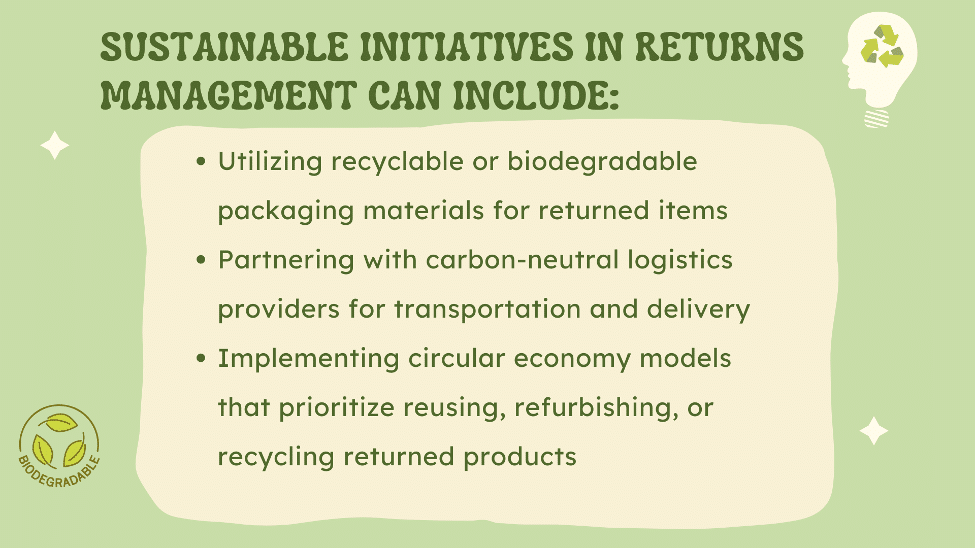Ecommerce returns are a fact of life, with studies showing that 30% of online purchases get sent back. Although returns may appear burdensome for your business, this article explores how you can turn them into a positive aspect.
Let’s explore the top 10 trends in ecommerce returns processing, showing you how to make the process smoother for both you and your customers. Discover strategies to reduce costs, enhance customer satisfaction, and gain valuable insights from your returns data.
1. Automation in Returns Management
Returns are an inevitable part of eCommerce, but managing them efficiently is critical for maintaining customer satisfaction and controlling costs. Automation tools, also known as returns management solutions, are revolutionizing this aspect of the business by reducing manual errors, streamlining processes, and speeding up the overall cycle.
These returns management solutions usually comprise software platforms automating various aspects of the returns process. They can handle tasks such as generating return labels and tracking numbers, automating communication with customers through email and SMS updates, integrating with order management and inventory systems for seamless restocking, and providing real-time visibility into return statuses and reasons.
Businesses can significantly reduce the time and resources required for manual processing by leveraging these advanced returns management solutions, leading to faster turnaround times and enhanced overall efficiency in handling returns.
2. Advanced-Data Analytics for Predicting Returns
While automation handles the logistics, analyzing return reasons and patterns through advanced data analytics can help businesses identify the primary causes of returns. This insight enables them to make targeted improvements that further reduce return rates and associated costs.
eCommerce businesses leverage predictive analytics and machine learning models to forecast return rates accurately based on various factors, such as product category, customer demographics, and purchase history.
Strategies driven by big data insights have proven effective in minimizing returns, such as:
- Optimizing product descriptions and imagery to set accurate expectations
- Improving size guides and fit recommendations based on customer feedback and data
- Tailoring marketing campaigns and promotions to the right audience segments
By addressing the root causes of returns through data-driven strategies, businesses can enhance customer satisfaction, reduce operational costs, and improve overall profitability.
3. Eco-Friendly Practices in Returns
As consumer awareness and demand for sustainable practices continue to grow, eCommerce businesses are adopting eco-friendly methods to minimize waste and their environmental impact during the returns process.

By incorporating green practices into their returns policies and processes, businesses can not only meet customer expectations but also contribute to environmental conservation efforts.
4. Seamless Reverse Logistics
Optimizing reverse logistics is crucial for eCommerce businesses, given the staggering cost of returns. Inefficient handling of reverse product flow can lead to increased expenses, longer processing times, and customer dissatisfaction.
Companies are leveraging technology solutions to streamline various aspects of reverse logistics, such as:
- Automating return pickups and scheduling for improved efficiency
- Implementing centralized return processing centers for better coordination
- Utilizing advanced inventory management systems for accurate restocking
By optimizing their reverse logistics operations, businesses can ensure efficient handling of returned products, minimizing costs and maximizing the value recovered from returns.
5. Integration of Blockchain for Transparency
Blockchain technology offers a promising solution for enhancing transparency and security in the return process by providing an immutable, decentralized record of transactions. This tamper-proof ledger can bolster trust between parties involved in the returns cycle.
Retailers can leverage blockchain to:
- Verify product authenticity and provenance, reducing the risk of counterfeit returns
- Track return shipments in real-time, providing visibility to all stakeholders
- Streamline refund processing by automating the validation and execution of refunds
By integrating blockchain into their returns management systems, businesses can increase accountability, reduce fraud, and provide customers with a more transparent and secure experience.
6. AI-Driven Personalization to Reduce Returns
One of the primary reasons for returns in eCommerce is mismatched expectations due to a lack of personalization. By leveraging artificial intelligence (AI) and machine learning algorithms, businesses can accurately predict customer preferences and deliver highly personalized experiences.
AI-powered personalization tools can significantly decrease return rates stemming from mismatched expectations by:
- Providing personalized product recommendations based on individual preferences and purchase history
- Offering virtual try-on and fit assistants for apparel and accessories
- Curating customized shopping experiences tailored to each customer’s unique needs and interests
These personalization techniques help customers make informed decisions, increasing the likelihood of finding the perfect product and reducing the need for returns.
7. Enhanced Customer Service Interfaces
Seamless customer service is pivotal in the post-purchase journey, as it can significantly influence a customer’s decision to initiate a return or repurchase. Innovations like AI-powered chatbots, augmented reality support, and conversational interfaces are enhancing the returns experience.
By providing efficient, personalized support, businesses can proactively address customer concerns, offer guidance on product usage or fit, and potentially minimize potential returns. Additionally, streamlining the returns process through user-friendly interfaces can foster customer loyalty and encourage repeat purchases.
8. Flexible Return Policies and Their Popularity
Offering flexible return options is a growing trend in eCommerce, as it fosters customer loyalty and trust. Popular flexible policies include:
- Extended return windows, providing customers with ample time to evaluate their purchases
- Free return shipping, eliminating additional costs for customers initiating returns
- Hassle-free exchanges, allowing customers to swap for a different size, color, or product without hassle
By implementing flexible return policies, businesses create a risk-free shopping experience for customers, increasing their satisfaction and likelihood of repeat purchases. Additionally, these policies can attract new customers who prioritize convenience and risk mitigation when shopping online.
9. The Rise of Return Insurance Services
Return insurance services have emerged as a solution to mitigate financial risks associated with returns for both consumers and retailers. These services offer return protection plans, reimbursing customers for eligible returns within a specified period and under certain conditions.
Benefits of return insurance include:
- Increased consumer confidence in purchases, leading to higher conversion rates
- Reduced losses for retailers by sharing the financial burden of returns
- Streamlined return claim processing through dedicated insurance providers
By partnering with return insurance providers, eCommerce businesses can provide an additional layer of security to customers, potentially increasing sales and customer loyalty.
10. Real-Time Returns Processing
With technological advancements in supply chain management and logistics, businesses can now process returns in real time, providing customers with instant updates and refunds.
Real-time processing enhances:
- Inventory management: Enabling seamless restocking of returned items as soon as they are received
- Customer satisfaction: Keeping customers informed throughout the process, fostering transparency and trust
This level of immediacy and transparency in returns processing is redefining the customer experience and setting new standards in the eCommerce industry.
Frequently Asked Questions
1. What are the primary challenges faced by businesses in automating their returns process?
Common obstacles include integration issues with existing systems, upfront costs of implementing new software and training employees to adapt to the automated workflows effectively.
2. How can companies ensure their reverse logistics operations are environmentally sustainable?
Partnering with eco-conscious logistics providers, utilizing recyclable packaging materials, and implementing circular economy models that prioritize reusing and refurbishing returned products are effective sustainability strategies.
3. What role does customer feedback play in shaping return policies and processes?
Customer feedback is invaluable in refining return policies and processes. Businesses closely analyze feedback to identify pain points, address concerns, and tailor policies to meet evolving customer expectations, fostering loyalty and trust.
Conclusion
As eCommerce continues to thrive and customer expectations evolve, efficient returns management is pivotal for fostering customer loyalty and driving operational excellence. By embracing these top trends, businesses can create a seamless, sustainable, and personalized returns experience, setting themselves apart in a highly competitive landscape.

